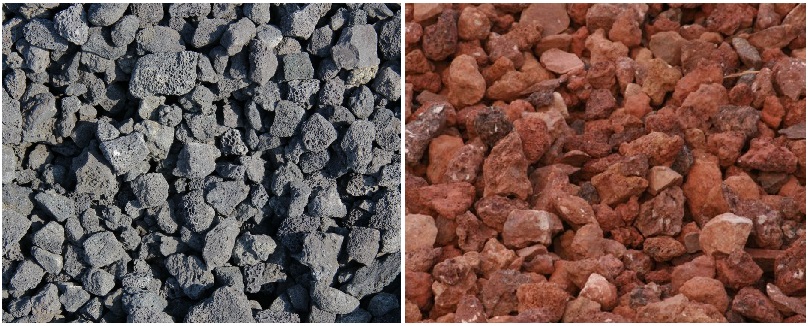Lava Rock

Two different examples of lava rock. If you look closely at the gray photo, you cna see the porous pockets within many of the individual pieces. The reddish rock has the same porous features but they are harder to see in that individual picture.
Lava rock is a lightweight, natural, pH neutral material that is much more porous than any other type of rock. Mined from natural lava deposits, the larger chunks are then fractured into smaller more convenient sizes. Most horticultural versions of this rock will feature irregularly sized chunks of material ranging in size from less than 1" to several inches long. It is typically orange, red, or gray in color.
Advantages and Disadvantages
This
natural material has some intriguing advantages. The larger pieces are much
easier to use and dramatically lighter than either gravel or sand, yet is heavier
than perlite and permiculite. It has good water retention capacity due to all
its little pockets and irregular stone faces, which all form tiny little
reservoirs that roots can draw from between irrigation cycles.
It can be dusty when you first get it, but it rinses clean fairly quickly. The
cost is higher than gravel and sand, and depending on your location may be more
costly than perlite and vermiculite, but it is often cheaper than rockwool or
hydroton. It's irregular shape, along with its larger size, can create
problems when trying to fill numerous identical small containers, such as
3" pots for transplanting purposes. However, some
manufacturers have released rock products specifically intended for
horticultural use, with much smaller (less than 1") average rock
size. Some suppliers will offer screened and sorted rock options such
that growers can specify the size and shape that works for them. Some
rock will either release dust which can change the pH, or the parent material
itself is soft enough to slowly release particulates that will change pH.
Monitor the pH over time to ensure it's not changing significantly. And
finally, some of the earlier versions of rock, particularly the larger
materials intended for landscaping, have jagged edges which can sever roots
(and scratch up hands). Newer materials are tumbled to remove such sharp
edges.
As we continue with our hydroponic work we will be experimenting
with this substance. We will report on our findings after some experience.
Where to find Lava Rock
Lava rock is not nearly as common as some other growing media supplies, but
it can be found. A good first stop would be your local hardware store or home
improvement store, since it is sometimes used in landscaping. They may not carry it as regular stock, but they can
probably special order it for you. They may need to order at least
a pallet's worth as a minimum order, so be sure to check how much rock you'll
need, and that will help determine whether your order meets the minimum special
order requirements.
A second local source would be landscaping suppliers or topsoil suppliers. They
may have bagged rock but will more likely have it in bulk, priced either by
volume or weight. They may be able to offer lower prices than the hardware
stores or home improvement stores since they already carry it in bulk. But
check prices on both to see who offers the best deal.
A third option is to try online hydroponic suppliers. Some will carry bagged
rock specifically for planting purposes. Or they may know of local or regional
suppliers. This type of growing medium doesn't ship as well as some
other soil amendments due to the weight and bulk, but it's worth a try to see
what they might have. One example is lava
rock available through a Hawaiian manufacturer, sold through Amazon.com.